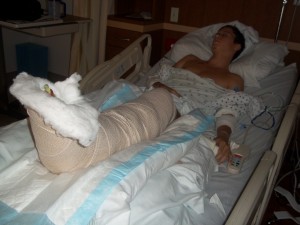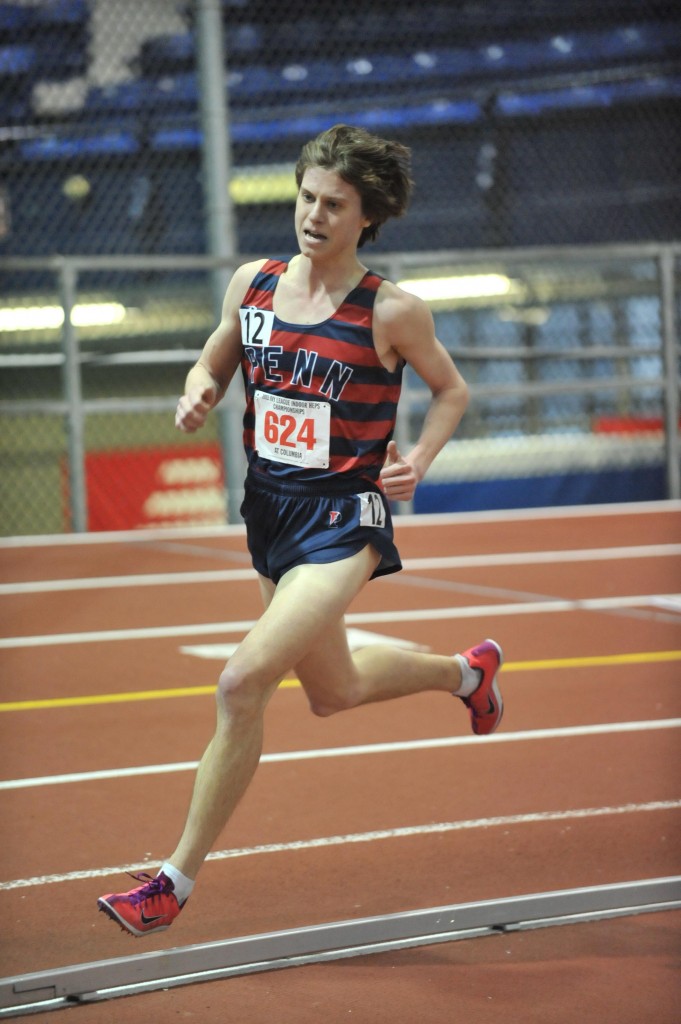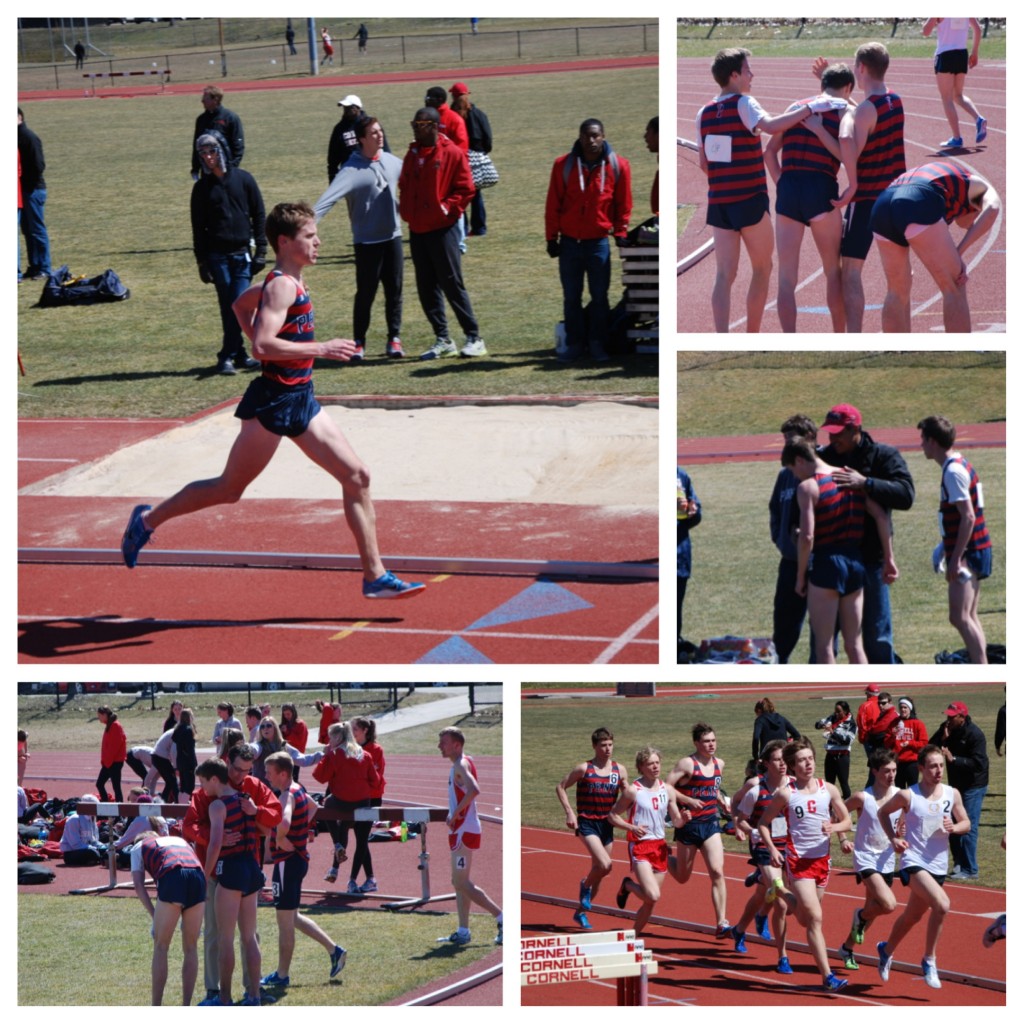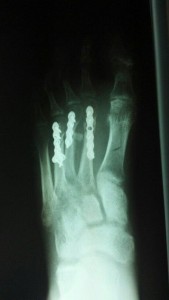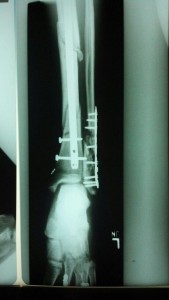Conner Paez: Meet LetsRun.com’s Inspirational/Blue Collar Runner Of The Week II
“Please don’t cut off my leg. Please just don’t amputate my leg. I can’t lose my leg. I need to run.”
by Robert Johnson, LetsRun.com
April 19, 2013
A few weeks ago, we introduced you to our unofficial first inspirational runner of the week – Eritrea’s Teklemariam Medhin – who slept on the floor in an airport for two days before going out to win a bronze medal at the 2013 World Cross-Country Championships.
Let us introduce you to our second. His name? Conner Paez – a junior at the University of Pennsylvania. His performance? He ran a 1,500 in 4:19.27 on April 6th.
How could a 4:19 1,500 meter runner – that’s barely under a 4:40 mile – be our athlete of the week?
Let me explain.
Two years ago, Conner Paez was on top of the world as a freshman at Penn University.
While he’d enjoyed some success at the high school level as he was the runner-up as the 2009 Ohio state cross country meet, he was far from an elite Ivy League recruit thanks to his modest 4:19/9:33 personal bests and 35th place Foot Locker Midwest showings.
For comparison’s sake, just take a look at the Ivy League schools that had the top recruiting classes that year distance-wise – Princeton and Columbia. Princeton brought in two Foot Locker finalists, two more sub-9 guys and a sub-9:10 while Columbia brought in five guys who were more than 10 seconds a mile faster than Paez’s 9:33 in HS, plus a sixth who had run 9:14 and was the son of an Olympian. And then there are five other schools in the League as well besides Penn, Princeton and Columbia.
Yet at the end of the fall, guess who was the top freshman finisher at the Ivy League cross country championships?
Conner Paez, thanks to his 20th place finish, as the Quakers surprisingly finished fourth in the Ivy League as a team.
In track, Paez’s continued his lofty rookie campaign as he ran an 8:16 3,000 indoors (equivalent to 8:52+ for 3,200) and a 14:18 5,000 outdoors. He had improved by leaps and bounds, as if you run an even-pace 14:18 5,000, you go through the 3,200 in 9:09 and keep it up for an extra 1,800 meters.
The sky seemed to be the limit. Then suddenly changed for Paez.
Everything Changed In An Instant
On August 7th , 2011, Paez was going through an intersection on his motorcycle. A car headed in the other direction was stopped waiting for Paez to pass the intersection so they could turn left. A driver behind the stopped car was in a rush and didn’t see any cars coming and tried to bypass the stopped car by veering to the right before making a hard left for himself. Well, he got around the stopped car and when he did so, the left side of Paez’s bike and body was right there to take the brunt of his impact.
Thrown and dragged at least 15 feet, Paez was badly injured.
Severe road rash was the last of Paez’s worries. If you thought the recent sight of Kevin Ware of Louisville was horrific looking with a single bone sticking out, Paez’s was worse as he had several open, compound fractures and several dislocations of his bones and joints. Altogether there was a total of eight broken bones with several sticking out of the severely damaged (and dirtied) skin. His left tibia was broken in three pieces and the fibula had such a bad fracture that a portion of bone was missing.
Oh, yeah – and all of the metatarsals in his left foot were broken – they appeared snapped like twigs – and his big toe was broken and dislocated. All told, it was a devastating injury that left Conner at risk of amputation of his leg.
“If you saw the Louisville basketball player’s (Kevin Ware)’s leg snap, Conner’s was more horrific,” said Dr. Mark Mendezzon, a family friend who would eventually operate on Paez.
As for pain, Paez said it was excruciating when I asked him about it. “It was by far the worst pain I could imagine. It was really bad. Yeah, it was bad.”
After his initial surgery after the accident, Paez spent a week in the hospital. Initially, his plan was to return to school for the fall semester, but once in Philadelphia, a doctor there told him he 100% needed to have additional surgeries, so Paez took the fall semester of 2011 off and returned to Ohio to have his operations done at home.
The additional surgeries also resulted in some severe complications to deal with. The biggest being that a wound in his left leg did not heal and the tibia developed a bone infection. This was a major concern because the tibia fracture already was at risk for not healing due to it being broken into three pieces and the fracture was at risk of healing into a deformed position. Two surgeries were needed to clean the bone infection and to remove some of the hardware to allow the bone to heal. If that wasn’t bad enough, the bone infection (Pseudomonas) was an unusual bacteria for his type of injury and thus required six months of intravenous antibiotics and dressing changes that Paez had to administer himself.
During the initial healing process, Paez’s big toe joint developed arthritis due to the magnitude of the dislocation fracture and lost its normal range of motion. His second toe developed gangrene and it was suggested he have it amputated. The second toe was saved with dressing changes and time.
In the end, thanks to six surgeries, Paez didn’t lose his foot, leg or any of his toes, but it was clearly far from a smooth ride. At one point, Paez had roughly 25 screws, four plates, a cadaver bone graft and a nearly two-foot rod in his body. After returning to Penn for the spring 2012 semester, in the summer of 2012 he returned home for additional final surgeries.
All of the screws and plates in his foot and leg had to be removed. Fortunately the bones all healed or were were mending well except for the bone graft in the fibula. The unhealthy bone was removed and antibiotic surgical cement beads were placed to eradicate the bone infection. In addition, a skin graft was taken from his thigh to heal the non-healing wound on his leg. Six weeks later, he returned to surgery to have the antibiotic cement removed and replaced with bone graft from his hip to repair the fibula.
By the time fall semester 2012 commenced, Conner was finally allowed to rehabilitate and learn to walk, jog and run.
“Please don’t cut off my leg. Please just don’t amputate my leg. I can’t lose my leg. I need to run.”
As I prepared to interview Paez last week, I reminded myself to ask Paez when he first contemplated a return to running. However, the question proved to be totally unnecessary as when I asked him to describe the accident, it’s clear that running was the first thing on his mind.
Paez: When I landed, it took me probably a couple minutes to realize exactly how bad my injuries were. I was kind of lying there dazed for a little bit. And then I actually looked at my leg, and it was pretty shocking. My shoe completely flew off. My pants were all shredded up. I looked at my leg, and I could see that it was completely crooked. It was like zig-zag shaped. My foot was totally mangled. I can’t even describe how it looked. All the toes are just in different directions. I could see one of my metatarsals was sticking out the bottom of my foot. I could see like the tip of my tibia was sticking out the side of my leg.
It was just very shocking. I can’t even describe how terrifying it was. The whole time I was like … really what I thought was, “I’m never running again.” I was like, there’s no way. I was so freaked out.
When the ambulance eventually came, they were looking at all my injuries and everything. The whole time I was just asking, “Please don’t cut off my leg. Please just don’t amputate my leg. I can’t lose my leg. I need to run.” It was so scary …
Me: You were worried about running right from the get-go – when you were on the ground? Weren’t you worried about dying?
Paez: (I knew) I wasn’t like dying. Of all the things, my life pretty much was running. The second I saw my leg and the first thing that went through my mind was, “I’m not going to run.”
So the whole time, I was thinking, “I’m never going to be able to run.” It was just terrifying to me.
The doctor in Philadelphia who told Paez that he needed additional surgeries also had even more devastating news for Paez:
He’s just like, “You’re not going to be able to run again. At least, definitely not competitively.” He’s like, “You’re injuries are just too bad. We’ll get you to the point where you can walk, hopefully without a significant limp, but running competitively, at least where you were, is just completely out of the question.”
That was the biggest blow. That was the hardest news I’ve ever had to hear in my whole life. I didn’t know what to do with myself anymore. If I didn’t have running, I didn’t even know what I was supposed to do.
Not Everyone Gave Up – Especially Paez
Paez found some encouragement from Dr. Mark Mendeszoon, a Chardon, Ohio foot and ankle surgeon who ran track and field at Miami (Ohio) before coaching collegiately at Stony Brook (paid) and then at Penn (as a volunteer while in medical school).
Mendeszoon, who also co-owns two running stores, knew Paez was extremely driven. Mendeszoon also knew the important role that running plays in many competitive athletes’ lives.
“He was the only one the whole time that was saying, ‘I believe in you. You can run.’ I think it was more he just knew who I was and how determined I was to get better,” said Paez.
Paez said that being told he wouldn’t ever run again competitively simply motivated him to get back to the sport he loved.
“Even though it was a really big blow, it kind of almost fueled my fire even more. I wanted to prove them wrong and show everybody what I could do, what I could come back from. I’d never give up on my dreams of making it to nationals and hopefully being All-American and everything. It was the biggest setback, but the whole time I was still determined I was going to run again. I was going to prove to everybody that I could do it. Pretty much the whole time I was just super determined,” said Paez.
A Long Rehab
In terms of a comeback, Paez said he soon made physical therapy his “life,” which was a good thing as there was a lot of it required to get his tiny atrophied leg back to where it needed to be – painstaking treatment to breakup all of the scar tissue, improve range of motion and flexibility, ultrasound, electrical stimulation, weight room training, swimming, biking, elliptical, walking, anti-gravity treadmill work, etc.
“Whenever I was up in my room, I was doing exercises on my own. I just never really accepted that I wouldn’t race,” said Paez.
Paez was taken off of crutches and allowed to walk in a boot in December of 2011. He was taken out of the boot and started to walk with a limp in his shoes at the end of January 2012.
In September of 2012, Paez got the green light to start jogging as his orthopedic surgeon said his leg was now strong enough to take the impact of very minor jogging. But Paez’s physical therapist soon watched Paez jog and immediately put a halt to the jogging.
“I went to my physical therapist and he looked at me try to jog around the track a little bit and he said, ‘You’re still not ready. Maybe your tibia and fibula can handle the impact, but in regards to what your form looks like and how it’s going to affect the rest of your body from trying to run on the leg, (it’s not good),'” said Paez as he was “severely limping” when trying to run.
So Paez went back to another 3 months of non-running physical therapy before trying again in December. From one mile every other day to 1.5 miles every other day, then 2 miles, then 2.5 and so on, Paez slowly built up until the beginning of February when he got the news he’d been waiting to hear for the last 18 months.
“It was a very, very slowly build up until like the beginning of February when the physical therapist told me that I was ready to go. If I wanted to start trying to actually train, like run every day and do workouts, he’d be fine with it,” said Paez.
When asked what it felt like to get the green light, Paez couldn’t hide his enthusiasm:
It was one of the best days of my life!
I was just so excited to finally get back to normal. The whole time, from when I was allowed to start biking, stationary bike and everything, that’s all I did like every day. When everybody else was out training in the sun and everything, I would just go to the gym and go on the stationary bike and just bike for like an hour or two.
So to be able to finally … I wasn’t running with them, because they were still so much faster than me, but just to be out there in the same area with them, running around … it was an amazing feeling … to see maybe there’s a way out of this nightmare, that I might be able to finally get back into it a little bit.
In terms of his comeback, Paez said Penn’s new coach Steve Dolan (Paez was coached by former sub-4 miler Blake Boldon his freshman year and sophomore years at Penn) started him off with very easy stuff:
They started off without workouts that would probably be a joke to a high schooler. It was really slow pace, low distance, low reps. Very, very easy workouts. But for me to even be running a six-minute pace mile was absolutely exhausting when I first started. Then I got in shape a lot quicker than I thought. I would do like two workouts a week and slowly just started to build up mileage and try to get back into it.
Paez, who ran 60 to 70 miles a week by the end of high school, and 90 mpw as a freshman at Penn under Boldon, has progressively built his mileage up to a level that his starting to approach his high school level as he’s now at 50-mile weeks.
As for his first race, the 4:19.27 1,500 at Cornell on April 6th, Paez said he pretty much accomplished what he set out to do:
I had pretty realistic goals. I wasn’t expecting to go out and PR or anything, or try to win the race. Really, I just wanted to finish and not be atrociously far behind everyone else. I was hoping like maybe run under 4:20 for the 15. So it’s still thirty seconds slower than my PR. That’s what I was trying to do. When I actually started the race, it was shocking because it was this pace I was not used to at all.
The Happiest He’s Ever Been After A Race
When asked as to what his reaction was to finishing the race and how his teammates responded, Paez got emotional:
When I finished, the guys in the race that ran with me all hugged me after. When I walked off the track, all my teammates were hugging me and the coaches and everything. That’s when I got really emotional. I started crying after the race and everything!
Even though it is the slowest time I’ve run in probably five or six years, it was the happiest I’ve ever been after a race by far. It felt so amazing. It was like the start of coming back. I expect to get a lot, lot better. It was just amazing that I could kind of prove it to myself, that I could do it, that I could come back from something that people said I’d never be able to do, and get back into actually competing collegiately.
As for the future, Paez said in the short term, he might run one or two more races this spring but the opportunities are limited as he’s not really at a division one level of fitness yet.
As for his long-term future, in terms of his goals, it probably won’t surprise you to hear that the super-motivated Paez hasn’t changed them at all:
Honestly, they’re the same as they were before my accident. I’m really confident in what I can do and that I can keep getting better. I have an extra year of eligibility, so I’m going to use that at Penn. So I’ll have two more years after this year. Hopefully, next year I’ll just be an actual contributor to the team. Hopefully be on the varsity squad in cross. Then from there, just keep getting better until, hopefully, I’m getting PRs again and maybe make it to nationals or something.
A few postscripts (PSs).
PS #21: Considering Kevin Ware’s injury had been dominating the headlines for much of April, I asked Paez if if he had seen it and what he thought:
That was really tough to watch. I felt so bad for him because I knew exactly what he was going through and what was going through his head. I’m sure he was thinking how he’s never going to be able to compete, how severe … Seeing that was pretty much how my leg looked, plus my foot being all mangled up. It was really hard. It wasn’t hard in the sense of actually seeing it being gruesome or something, it was more just I felt so bad for him.
PS #2. Paez was full of praise for both his former coach, Blake Boldon, and current coach, Steve Dolan, and it reminded me what a privilege it was to coach in college for ten years. It’s a profession where if you truly care for the athletes, they are almost bound to love you.
Paez said he had an “extremely close relationship” with Boldon freshman year and that Boldon was incredibly supportive after the accident and drove out to Cleveland to spend time with him and then was very encouraging of Paez “staying on the team and helping out in any way” that he could. Paez said it was hard to see Boldon depart Penn.
However, he also was full of praise for new man Steve Dolan, whom he called an “amazing coach” and whom he said had done a fantastic job of adapting and customizing workouts for Paez to help me get back into it. Paez was optimistic that Dolan will be able to re-energize the Penn team, which hasn’t won an Ivy League title in more than a decade. “He’s a fantastic coach. He’s really done a lot with the team. He’s helped me out so much. It’s pretty amazing what he can do,” said Paez.
Kudos to both Boldon and Dolan for being there for Paez. I always said an athlete who is running well barely needs a coach. The ones who are injured or running poorly are the ones who most need a coach and it’s those athletes who are most often abandoned by college coaches.
PS #3. Paez did say now that’s he’s fully into his comeback that he’s worried about stress fractures in his foot or leg. “The bones are healed, but I can still feel where the breaks were and everything. So if those start to hurt again or if I have a slight discrepancy in my stride or something, that I got some injury to my hips or knees … that’s always going to be in the back of my mind.”
PS #4: It seems that Paez would be an ideal candidate for a sixth year of eligibility for cross-country and indoor track, which he’d have to use at another school as the Ivy League doesn’t allow grad students to compete.
More On Paez: We have three very graphic photos of Paez’s injury. Most of you will NOT want to view them but we figured some people would like to see what he came back from: Graphic Photo #1, Graphic Photos #2, Graphic Photo #3.
2011 Daily Pennsylvanian: Freshman builds on strong fall
*Paez’s Penn Bio
*Paez’s HS Stats (Milesplit)
*Paez’s College Stats (TFRRS)
